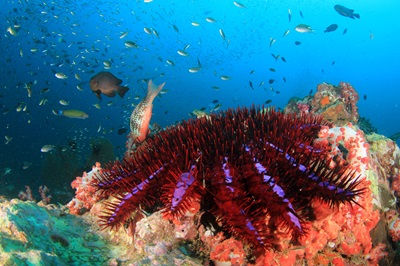 A DNA-based method of biodiversity monitoring has provided new insights into the early-life stages of several species, including the crown-of-thorns starfish (COTS), and could reshape how we detect and monitor similar species moving forward.
A DNA-based method of biodiversity monitoring has provided new insights into the early-life stages of several species, including the crown-of-thorns starfish (COTS), and could reshape how we detect and monitor similar species moving forward.
The honours project was led by The University of Queensland’s Ilha Byrne and partnered with the Australian Institute of Marine Science (AIMS) to review plankton samples from the Great Barrier Reef, revealing the importance of time in understanding larval distribution.
The plankton samples were originally collected by the AIMS team over a period of nearly 20 years, specifically for the purpose of detecting COTS larvae using a species-specific approach.
“We used an exciting approach called DNA metabarcoding, which is a method that allows researchers to identify multiple organisms from a single sample,” Ms Byrne said.
“It does this by essentially blending up samples and categorising, or ‘barcoding’, the DNA data extracted into their unique species.
“It’s a non-invasive, and in some cases time-and-cost-effective, method that provided us with a detailed snapshot of larval communities over time and space.
“While DNA metabarcoding has been around for over a decade, few studies have applied it to marine larvae in Australia.”
The study focused on two areas of the Great Barrier Reef – Moore Reef and an area spanning from Townsville to Lizard Island.
Results revealed significant seasonal variations in the diversity of echinoderm larvae, such as COTS, sea cucumbers, and sea urchins.
“Echinoderms play a crucial role in marine ecosystems, with COTS known for their periodic population explosions which can devastate coral reefs – so it’s vital we know as much as we can about them,” Ms Byrne said.
“While COTS are native to Australia, they can undergo massive population expansions or outbreaks, which pose a threat to the health of coral reef ecosystems.
“The improved understanding of this temporal variability is crucial for understanding population dynamics and ecosystem health.
“The metabarcoding approach provides a more efficient way to monitor these larvae, which are otherwise very difficult to detect and identify.
“Our collaborators at AIMS use a very similar but COTS-specific approach as a potential early warning system for impending outbreaks.
“Understanding the distribution and abundance of these larvae can improve our understanding of reproductive cycles, spawning periodicity, as well as species richness.”
Co-author, UQ’s Dr Iva Popovic said the research could pave the way for integrating metabarcoding with environmental and oceanographic data, potentially enhancing understanding of the factors influencing larval distribution.
“Comprehensive analyses such as this could revolutionise marine monitoring and conservation strategies worldwide,” Dr Popovic said.
“We’re excited about the potential of combining genetic tools with environmental data and believe it could provide deeper insights into the life history and ecological roles of marine invertebrates.”
This research is published in Coral Reefs.
Media: Ilha Byrne, i.byrne@uq.edu.au, +61 416 153 511; Dr Iva Popovic, i.popovic1@uq.edu.au, +61 450 658 950; Faculty of Science Media, science.media@uq.edu.au, +61 438 162 687.



